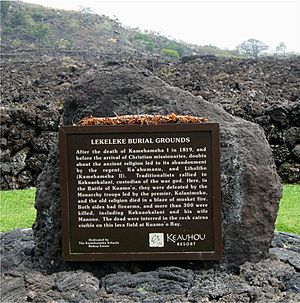Keaoua Kekuaokalani facts for kids
Quick facts for kids Keaoua Kekua-o-kalani |
|
|---|---|

Memorial at Kuamoʻo
|
|
| Died | December 1819 Kuamoʻo |
| Spouse | Manono II (probably others) |
| Father | Keliʻimaikaʻi |
| Mother | Kiʻilaweau |
Keaoua Kekua-o-kalani (sometimes called Kaiwi-kuamoʻo Kekua-o-kalani) was an important Hawaiian chief. He was the nephew of Kamehameha I, the famous king who united all the Hawaiian islands. Keaoua played a key role in a major event in Hawaiian history after Kamehameha I passed away.
Contents
Keaoua's Family Background
Keaoua Kekua-o-kalani was the son of Keliʻimaikaʻi, who was King Kamehameha I's younger brother. His mother was Kiʻilaweau, who was Kamehameha I's half-sister. This made Keaoua closely related to the royal family. His grandmother was Manono I, and his wife was Manono II.
After Kamehameha I died in 1819, his son Liholiho became the new king. Keaoua did not agree with some of Liholiho's big changes. This led to a short rebellion, and Keaoua was killed in battle around December 21, 1819.
What Was the ʻAi Noa?
After King Kamehameha I died, his son Liholiho (King Kamehameha II) took power. Important female chiefs, like Kaʻahumanu, encouraged Liholiho to make a huge change. They decided to end the old Hawaiian system called kapu.
The kapu system had been a set of strict rules that guided life in Hawaiʻi for many centuries. For example, men and women were not allowed to eat together, and women could not eat certain foods. Also, official worship at the stone temples, called heiaus, was stopped. This major event was called the ʻAi Noa, which means "free eating." It showed a big shift in Hawaiian society and religion.
Some historians say that even though the state religion changed, common people could still worship their family gods. Hula teachers could still make offerings, and people on Hawaii Island could still honor the goddess Pele. However, King Liholiho ordered all heiau temples across the islands to be destroyed. Many people saw this as a complete rejection of the traditional Hawaiian religion.
Why Keaoua Rebelled
Some chiefs believed that if they gave up the kapu system and stopped worshipping at the heiaus, they would lose their power and the religious reasons for their rule. They worried that King Liholiho was making a dangerous choice that could harm everyone.
It's also likely that many people, including Keaoua, felt a strong loyalty to the old cultural rules and religious beliefs they had grown up with. Keaoua was very upset by the decision to abandon these sacred traditions. He left the royal court and went to Kailua-Kona on Hawaii Island, then moved to Kaʻawaloa at Kealakekua Bay.
Many people who disagreed with the ʻAi Noa joined Keaoua. They encouraged him to try and become king, saying, "The chief who prays to the god, he is the chief who will hold the rule." Some Hawaiians in Hamakua even started a rebellion and killed some soldiers sent against them. Keaoua had been trained as a priest by Hewahewa, who was the high priest but had joined Liholiho in rejecting the old religion. Because of this, Keaoua took on the role of high priest himself and decided to defend the old religion by force.
Sending Messengers
King Liholiho and his chiefs talked about what to do. They decided to send messengers to Keaoua. They asked him to stop his defiance, return to Kailua, and join the "free eating." Keaoua seemed to listen respectfully to the messengers. He said he was ready to go back to Kailua the next day, but he would not join the free eating. The messengers went to rest, thinking the problem was solved.
However, Keaoua's supporters spent the night trying to convince him to kill the messengers and start a full rebellion. Keaoua refused to harm the messengers. But the next morning, when he and his followers were supposed to get into canoes to return to Kailua, he changed his mind. He said he and his men, who were dressed in warrior gear, would travel by land instead.
The Battle at Kuamoʻo
Keaoua's decision to travel by land with his warriors was a clear sign of war. King Liholiho sent his forces, led by Kalanimoku, to stop Keaoua. The two armies met at Kuamoʻo, just south of Keauhou Bay.
During the battle, Keaoua was killed by rifle fire. His wife, Manono, who was Kalanimoku's sister and had fought alongside her husband, was also shot down. The rest of Keaoua's army scattered, and King Liholiho won the battle completely. This battle was the only armed rebellion in Hawaiian history fought to protect the traditional native Hawaiian religion.
Keaoua's Legacy
Keaoua Kekua-o-kalani is remembered as the last recognized high priest and the final defender of the traditional native Hawaiian religion for a long time. In more recent times, there have been efforts to revive parts of the old religion. The gymnasium at Old Kona Airport State Recreation Area is named in his honor, remembering his place in Hawaiian history.

